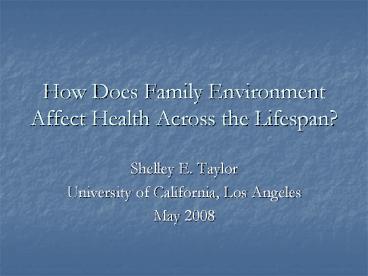How Does Family Environment Affect Health Across the Lifespan? - PowerPoint PPT Presentation
1 / 22
Title:
How Does Family Environment Affect Health Across the Lifespan?
Description:
How Does Family Environment Affect Health Across the Lifespan? Shelley E. Taylor University of California, ... Department of Psychology Created Date: – PowerPoint PPT presentation
Number of Views:176
Avg rating:3.0/5.0
Title: How Does Family Environment Affect Health Across the Lifespan?
1
How Does Family Environment Affect Health Across
the Lifespan?
- Shelley E. Taylor
- University of California, Los Angeles
- May 2008
2
A lifespan model of the impact of threat
responses on mental and physical health outcomes
3
Developmental origins of responses to threat
- Early environment affects health not only in
childhood but throughout adulthood into old age,
controlling for other risk factors - Childhood SES predicts health outcomes,
controlling for adult SES - A harsh early family environment (conflict, cold,
and/or neglectful, hereafter referred to as
risky families) predicts adverse health
outcomes
4
Risky Families Questionnaire (Sample Items)
- 1. How often did a parent or other adult in the
household make you feel that you were loved,
supported, and cared for? - 2. How often did a parent or other adult in the
household swear at you, insult you, put you down,
or act in a way that made you feel threatened? - 3. How often did a parent or another adult in the
household express physical affection for you,
such as hugging or other physical gesture of
warmth and affection?
5
- Relation of Adverse Childhood Experiences and
Risk of Major Chronic Diseases - Health Problem Amount of Abuse
Adjusted Odds Ratio - Ischemic
0
1.0 - heart disease
1
0.9 -
2
0.9 -
3
1.4 -
4 or more
2.2 -
Total
--- - Any cancer
0
1.0 -
1
1.2 -
2
1.2 -
3
1.0 -
4 or more
1.9 -
Total
--- - Stroke
0
1.0 -
1
0.9
6
Specific mechanisms
- What are the mechanisms that underlie these
relations, i.e. by what routes are the effects of
early environment maintained? - We focus on
- Alterations in Biological Stress Regulatory
Systems (Study 1) - Neural regulation of stress responses (Study 2)
7
Study 1Question Does Early Environment Affect
Biological Stress Regulatory Systems?Procedure
- Participants 92 students aged 18-25, prescreened
for medical and psychological problems - Participated in laboratory stress task of
counting backwards as rapidly as possible by 13s
from 9,095 - Taylor, S.E., Lerner, J.S., Sage, R.M., Lehman,
B. J., Seeman, T. E. (2004).
8
(No Transcript)
9
Results
- Harsh early environment is associated with an
elevated flat trajectory of cortisol responses to
stress
10
(No Transcript)
11
Results
- Among males only, very harsh family environment
is associated with elevated heart rate and blood
pressure.
12
13
Conclusions
- A harsh early family environment is associated
with compromised biological responses to threat
and poorer self-rated health. - Provides potential mechanism for long term health
effects of early family environment (allostatic
load).
14
Study 2Family environment and coping
- Children from risky families show
- High levels of avoidant coping
- Overly aggressive responses to stressors
perceived by others to be only moderately
challenging - Ineffective coping (Coping that does not reduce
experienced stress) - Question Any neural evidence for these processes?
15
Brain candidates for regulation of stress
responses
- Amygdala, tied to threat detection and fear
responses - RVLPFC (right ventrolateral prefrontal cortex),
believed to regulate amygdala responses to threat
16
Participants
- 30 healthy, right-handed adults, age 18-36 (12
men, 18 women) - Participants responded to 3 tasks in blocked,
randomized design (Observe Only, Label Emotions,
Label Gender)
17
Observe only
Label emotions
Label gender (Control Task)
18
In the observe only task, offspring from harsh
environments show significantly lower amygdala
activity, suggesting they are tuning out the
stimuli
19
Results from labeling task
- Amygdala responses of those from harsh families
significantly higher than those from nurturant
families - RVLPFC activity significantly negatively
correlated with amygdala responses in low RF
families significantly positively correlated in
high RF families
20
r .66
r -.44
21
What do these results mean?
- Offspring from risky families may shut out
threatening cues with which they do not need to
engage - When forced by task demands to engage, amygdala
response is stronger - Offspring from risky families do not recruit
RVLPFC effectively for regulating amygdala
responses to threatening stimuli
22
Conclusions
- Growing up in a risky family environment marked
by harsh parenting has effects on neural
processes involved in threat detection and
regulation of responses to threat - Offspring from risky families may not have
effective threat detection and emotion regulation
skills for coping with stressful circumstances - Taylor, S. E., Eisenberger, N. I., Saxbe, D.,
Lehman, B. J., Lieberman, M. D. (2006).
Biological Psychiatry, 60, 296-301.































